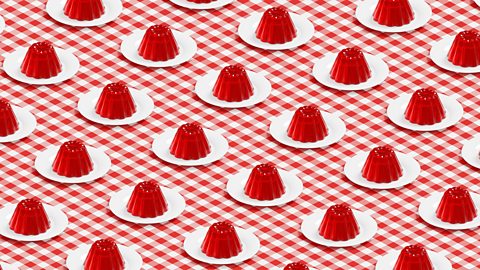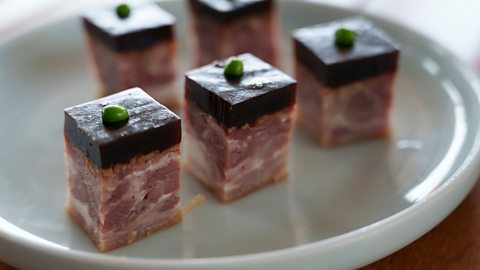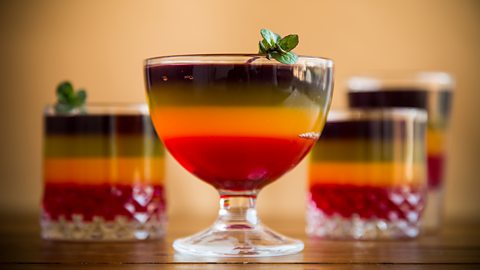By Veronique GreenwoodFeatures correspondent

 Getty Images
Getty ImagesGelatine, made from the connective tissues of animal parts, is an unlikely staple ingredient. Even when food fashions change, it always seems to make a comeback
To make the first known recipe for an aspic, you'll need fish lips. These dainties are to be suspended in a set gelatine, flavoured with a riot of spices and made from boiling Iraqi carp heads, before being tinted a brilliant red with saffron.
A thousand years ago in Iraq, when the cookbook containing the recipe was written, party guests might have welcomed a slice of the jiggling substance, much the way the attendees of a Tupperware party in Omaha in 1963 would have tucked into a brilliant green molded Jell-O larded with canned mandarin orange slices.
Gelatine's story is much longer and weirder than you might expect, full of tower heights and crashing falls from grace – and, according to one historian, it is on the way back into the public eye.
For one thing, dishes made of gelatine are probably older than even this fishy example. Gelatine is made by boiling the bones and connective tissue of animals, breaking down the protein known as collagen. The proteins released by the process will cling together at room temperature, but if they are mixed with hot water and then allowed to cool, the water is threaded through the network they form. Different concentrations of the proteins will yield different firmness of the final gel.
For as long as people have been boiling bones, they have probably been making gelatine of some kind or another.

 Getty Images
Getty ImagesThen, there's the fact that gelatine has been incredibly fashionable, time and time again, says Ken Albala, a food historian at the University of Pacific in California and the author of The Great Gelatin Revival. In Europe, the late Middle Ages and early Renaissance saw a gelatine bonanza on the tables of the rich.
Albala points to the 1549 Italian collection of recipes Banchettifor one such example: majordomo Cristoforo di Messisbugo lays out in loving detail how to make gelatine from a capon, which was to be poured over the wings and other meat removed from the carcass and left to set in a dish.
One of the most fanciful versions comes from chef-to-the-pope Bartolomeo Scappi, who records it in 1570. After making gelatine from the feet of sheep and calves, you can divide it up and tint it different colours. Then, put one layer into the bottom of an empty eggshell, let it set, cover it with another layer tinted white with almond milk, let that set, and continue layering with different colours to get a rainbow-hued gelatine egg.
But it's also suffered tremendous declines in popularity. Around the 17th Century, gelatine seems to have gone into hibernation in Europe. In the early 1800s in England, it grew associated with somewhat racy establishments known as "jelly houses", where gelatine was served in cups and sex workers plied their trade.
It later returned to elite tables in the aspics of the Victorian Age, only to lose popularity in the early 20th Century, and then be revived again by the American behemoth Jell-O. In 1915 Jell-O released a recipe for Perfection Salad, which described suspending sliced cabbage, celery, and pimientos in Jell-O.

 Getty Images
Getty ImagesIt might sound dire to some modern readers, but to many people, particularly American housewives, it presented a clean, pure, easy way to feed your family using modern science (never mind the fact that gelatine, as we have seen, is quite old, and quite natural). Jell-O seemed connected to the faith in technology that characterised much of the first half of the 20th Century.
That is the driving force behind gelatine's rollercoaster, Albala suspects. "I think it has ultimately to with people's attitudes towards food processing," he says. "Do they want bright colours and artificial flavours? Do they want titillation, something exciting?" Or are the watchwords of a given age "tradition", "homemade", "old-fashioned"? There is a pendulum-like quality to people's feelings about food, if you are looking at the sweep of history. When novelty thrills eaters, a whole lobster hanging suspended into a crystalline cube of set gelatine is just the thing. When a retreat into the old ways is ascendant, gelatine is tacky, fake, unappetising.
You might also like:
That's why Albala thinks that aspics are likely to see a return to fine-dining tables soon. "We've been in a DIY hipster pickle era for a long time," he says. But younger eaters don't seem as bothered by the idea of foods that are manufactured as their predecessors, he adds. "They don't have that same aesthetic." The rise of Impossible Burgers and other plant-based simulacra of meat-based foods are testament to that. Technology is just means to an end.
Indeed, the popularity of the elaborate creations of Bombas and Parr, the London-based firm of jelly artists, speak to a growing interest in pushing the envelope with food. And it's not even necessary to boil animal bones to get something gelatinous anymore. There are many vegetarian stand-ins, including agar, which is made of algae and has long been used in Asian cuisines, and seaweed-based carrageen. All jiggle and no carcass is definitely an option today.
If you are inspired to whip up a jelly dish at home, Albala's book has a number of recipes for such oddities as a BLT in gelatine and jellied negronis. But if you would like to create your own, he has a few pointers: do not put fresh pineapples or papaya in, as they contain enzymes that prevent the gelatine from setting.
And much to his sorrow, he's discovered you can't suspend noodles in gelatine to make a jellied bowl of ramen. The proteins in the gel will draw the water from them so thoroughly that the noodles become hard, crunchy threads.
--
If you liked this story, sign up for The Essential List newsletter – a handpicked selection of features, videos and can't-miss news delivered to your inbox every Friday.
Join one million Future fans by liking us on Facebook, or follow us on Twitter or Instagram.
Gelatine: The ingredient with the wonder wobble - BBC.com
Read More

No comments:
Post a Comment